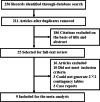Diagnostic performance of metagenomic next-generation sequencing for Pneumocystis jirovecii pneumonia
- PMID: 37430211
- PMCID: PMC10331973
- DOI: 10.1186/s12879-023-08440-4
Diagnostic performance of metagenomic next-generation sequencing for Pneumocystis jirovecii pneumonia
Abstract
Objective: Pneumocystis jirovecii pneumonia (PJP) can be a life-threatening opportunistic infection. We aimed to evaluate the diagnostic accuracy of metagenomic next-generation sequencing (mNGS) for PJP.
Methods: A comprehensive electronic literature search of Web of Knowledge, PubMed, Cochrane Library, CNKI and Wanfang data was performed. Bivariate analysis was conducted to calculate the pooled sensitivity, specificity, diagnostic odds ratio (DOR), the area under the summary receiver operator characteristic (SROC) curve and the Q-point value (Q*).
Results: The literature search resulted in 9 studies with a total of 1343 patients, including 418 cases diagnosed with PJP and 925 controls. The pooled sensitivity of mNGS for diagnosis of PJP was 0.974 [95% confidence interval (CI), 0.953-0.987]. The pooled specificity was 0.943 (95% CI, 0.926-0.957), the DOR was 431.58 (95% CI, 186.77-997.27), the area under the SROC curve was 0.987, and the Q* was 0.951. The I2 test indicated no heterogeneity between studies. The Deek funnel test suggested no potential publication bias. Subgroup analyses showed that the area under the SROC curve of mNGS for diagnosis of PJP in immunocompromised and non-HIV patients was 0.9852 and 0.979, respectively.
Conclusions: Current evidence indicates that mNGS exhibits excellent accuracy for the diagnosis of PJP. The mNGS is a promising tool for assessment of PJP in both immunocompromised and non-HIV patients.
Keywords: Bronchoalveolar lavage fluid; Diagnosis; Metagenomic next-generation sequencing; Pneumocystis jirovecii pneumonia; meta-analysis.
© 2023. The Author(s).
Conflict of interest statement
The authors declare no competing interests.
Figures








Similar articles
-
The diagnostic value of metagenomic next-generation sequencing for identifying Pneumocystis jirovecii infection in non-HIV immunocompromised patients.Front Cell Infect Microbiol. 2022 Oct 27;12:1026739. doi: 10.3389/fcimb.2022.1026739. eCollection 2022. Front Cell Infect Microbiol. 2022. PMID: 36389151 Free PMC article.
-
Risk factors associated with Pneumocystis jirovecii pneumonia in non-HIV immunocompromised patients and co-pathogens analysis by metagenomic next-generation sequencing.BMC Pulm Med. 2023 Feb 24;23(1):72. doi: 10.1186/s12890-022-02300-8. BMC Pulm Med. 2023. PMID: 36829171 Free PMC article.
-
Metagenomic next-generation sequencing promotes diagnosis and treatment of Pneumocystis jirovecii pneumonia in non-HIV infected children: a retrospective study.BMC Pulm Med. 2024 Jul 12;24(1):338. doi: 10.1186/s12890-024-03135-1. BMC Pulm Med. 2024. PMID: 38997717 Free PMC article.
-
Diagnostic accuracy of serum (1-3)-β-D-glucan for Pneumocystis jirovecii pneumonia: a systematic review and meta-analysis.Clin Microbiol Infect. 2020 Sep;26(9):1137-1143. doi: 10.1016/j.cmi.2020.05.024. Epub 2020 May 30. Clin Microbiol Infect. 2020. PMID: 32479781
-
Exploring the clinical and diagnostic value of metagenomic next-generation sequencing for urinary tract infection: a systematic review and meta-analysis.BMC Infect Dis. 2024 Sep 18;24(1):1000. doi: 10.1186/s12879-024-09914-9. BMC Infect Dis. 2024. PMID: 39294577 Free PMC article.
Cited by
-
Immune checkpoint inhibitor increased mortality in lung cancer patients with Pneumocystis jirovecii pneumonia: a comparative retrospective cohort study.Front Oncol. 2024 Jul 5;14:1398357. doi: 10.3389/fonc.2024.1398357. eCollection 2024. Front Oncol. 2024. PMID: 39035737 Free PMC article.
-
Integrating DNA and RNA sequencing for enhanced pathogen detection in respiratory infections.J Transl Med. 2025 Mar 14;23(1):325. doi: 10.1186/s12967-025-06342-4. J Transl Med. 2025. PMID: 40087699 Free PMC article.
-
Application of targeted next-generation sequencing for pathogens diagnosis and drug resistance prediction in bronchoalveolar lavage fluid of pulmonary infections.Front Cell Infect Microbiol. 2025 Jun 9;15:1590881. doi: 10.3389/fcimb.2025.1590881. eCollection 2025. Front Cell Infect Microbiol. 2025. PMID: 40552119 Free PMC article.
-
Trichosporon asahii co-infection with Pneumocystis jiroveci in a renal transplant patient.IDCases. 2024 Apr 15;36:e01951. doi: 10.1016/j.idcr.2024.e01951. eCollection 2024. IDCases. 2024. PMID: 38707649 Free PMC article.
-
Differentiation of Pneumocystis jirovecii pneumonia from colonization: a clinical decision framework incorporating risk stratification and next-generation sequencing thresholds.BMC Infect Dis. 2025 Jul 1;25(1):874. doi: 10.1186/s12879-025-11235-4. BMC Infect Dis. 2025. PMID: 40597711 Free PMC article.
References
-
- Weyant RB, Kabbani D, Doucette K, Lau C, Cervera C. Pneumocystis jirovecii: a review with a focus on prevention and treatment. Expert Opin Pharmacother. 2021;22(12):1579–92. - PubMed
Publication types
MeSH terms
LinkOut - more resources
Full Text Sources

